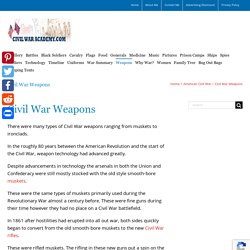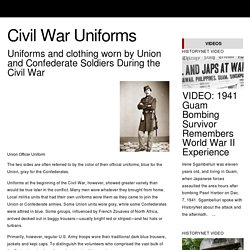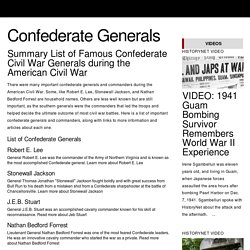

Civil War Weapons - Civil War Academy. There were many types of Civil War weapons ranging from muskets to ironclads.

In the roughly 80 years between the American Revolution and the start of the Civil War, weapon technology had advanced greatly. Despite advancements in technology the arsenals in both the Union and Confederacy were still mostly stocked with the old style smooth-bore muskets. These were the same types of muskets primarily used during the Revolutionary War almost a century before. These were fine guns during their time however they had no place on a Civil War battlefield. In 1861 after hostilities had erupted into all out war, both sides quickly began to convert from the old smooth-bore muskets to the new Civil War rifles. These were rifled muskets.
Civil War Rifle The new rifles also used a new type of ammunition. This projectile has the same pointed shape as today’s modern bullets and was much more accurate and inflicted much more damage than round ball ammunition. Examples of Civil War Rifles • Sharps Rifle. Civil War Uniforms. Uniforms and clothing worn by Union and Confederate Soldiers During the Civil War Union Officer Uniform The two sides are often referred to by the color of their official uniforms, blue for the Union, gray for the Confederates.

Uniforms at the beginning of the Civil War, however, showed greater variety than would be true later in the conflict. Many men wore whatever they brought from home. Local militia units that had their own uniforms wore them as they came to join the Union or Confederate armies. Primarily, however, regular U.S. Confederate Uniform volunteers were issued dark blue jackets and kepis but with light blue trousers. Confederate uniforms were gray kepi, jacket and trousers. On both sides, artillerymen had red kepis, shell jackets with red trim and, depending on rank, a red stripe on their pants legs.
There were other uniforms for special units—perhaps most famous were the green uniforms of Hiram Berdan’s Union sharpshooters—but the blue and the gray predominated. Teacher guide. Confederate Generals. Imagine a situation in the modern American army where officers refuse to fight under other officers, where generals openly defy and even strike their superiors, where officers are cashiered or relieved of command at a whim, where dueling challenges are routinely issued and accepted with no fear of official censure or retaliation.

Such a detrimental state of affairs would never be tolerated by either the civilian leadership or the military high command. Yet, this was precisely the situation that existed in Civil War armies on both sides, although the Confederate Army suffered more from its consequences. The Confederate officer corps was a collection of highly individualistic, temperamental and ambitious men. Honor and personal pride seemed to be at the root of most of their personal differences with each other, even to the point where these considerations were placed above the best interests of the Confederacy. Major General A.P. Floyd: I turn the command over, sir. Pillow: I pass it. Major Battles and Campaigns of the Civil War - American History: The Civil War and Reconstruction - LibGuides at John Jay College of Criminal Justice, CUNY. Robert E Lee Surrendering to US Grant at Appomattox 1865 Fought on April 9 1865, the final battle between the forces of General Ulysses Grant and General Robert E Lee was the Battle of Appomattox Court House.

Lee had spent the previous year defending Richmond but decided at this point to try and move south to link up with other Confederate forces. He was forced to retreat to Appomattox Court House by Union forces and in the end had no choice but to surrender. The documents signalling surrender were signed on April 9 and an official ceremony was held on April 12th disbanding the Army of Nothern Virginia that Lee had commanded. The effect of this was to end the war in Virginia and to trigger a wave of surrenders across remaining Confederate territory. Grant was generous in his terms; he allowed for the surrendering Confederates to keep their sidearms and horses, imprisioned no one, and supplied Lee's army with food rations. Secession - Definition, Civil War & Southern States. The Gettysburg Address by Abraham Lincoln. Nicolay Copy Named for John G.

Nicolay, President Lincoln's personal secretary, this is considered the "first draft" of the speech, begun in Washington on White house stationery. The second page is writen on different paper stock, indicating it was finished in Gettysburg before the cemetery dedication began. Lincoln gave this draft to Nicolay, who went to Gettysburg with Lincoln and witnessed the speech. The Library of Congress owns this manuscript. Four score and seven years ago our fathers brought forth, upon this continent, a new nation, conceived in liberty, and dedicated to the proposition that all men are created equal. Now we are engaged in a great civil war, testing whether that nation, or any nation so conceived, and so dedicated, can long endure. But, in a larger sense, we can not dedicate we can not consecrate we can not hallow, this ground The brave men, living and dead, who struggled here, have hallowed it, far above our poor power to add or detract.
Hay Copy Everett Copy.